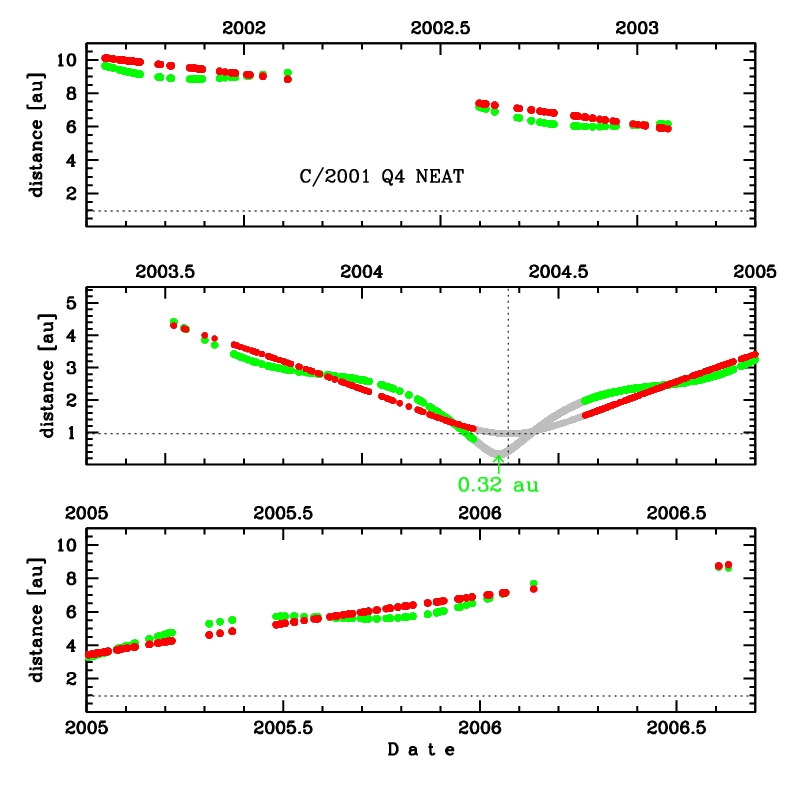| Solar System Dynamics & Planetology Group |
 |
C/2001 Q4 NEAT |  |
| Solar System Dynamics & Planetology Group |
 |
C/2001 Q4 NEAT |  |

| number of observations | 2681 |
| number of residuals | 5316 |
| data interval | 2001 Aug. 24 — 2006 Aug. 18 |
| rms [arcsec] | 0.56 |
| orbit quality class | 1a+ |
| Epoch (TT) | 20010730.0 | = JD 2452120.5 |
| time of perihelion passage (TT) | 20040516.066603 | ± 0.000023 |
| perihelion distance | 0.96136124 | ± 0.00000034 |
| eccentricity | 1.00056075 | ± 0.00000079 |
| argument of perihelion [deg] | 1.213428 | ± 0.000050 |
| longitude of the ascending node [deg] | 210.200138 | ± 0.000008 |
| inclination [deg] | 99.564090 | ± 0.000011 |
| inverse semimajor axis [10-6 au-1] | -583.29 | ± 0.82 |
| Nongravitational parameters [10-8 au/day2] | A1 = 1.6506 ± 0.0140 | A2 = 0.06241 ± 0.00610 | A3 = 0.00141 ± 0.00511 |
| Epoch (TT) | 17050831 | |
| time of perihelion passage (TT) | 20040516.039333 | ± 0.000036 |
| perihelion distance | 0.96047294 | ± 0.00000035 |
| eccentricity | 0.99994184 | ± 0.00000077 |
| argument of perihelion [deg] | 1.322963 | ± 0.000050 |
| longitude of the ascending node [deg] | 210.315484 | ± 0.000008 |
| inclination [deg] | 99.749234 | ± 0.000011 |
| inverse semimajor axis [10-6 au-1] | 60.56 | ± 0.81 |
| Epoch (TT) | 22941221 | |
| time of perihelion passage (TT) | 20040515.816463 | ± 0.000020 |
| perihelion distance | 0.96128328 | ± 0.00000017 |
| eccentricity | 1.00066754 | ± 0.00000044 |
| argument of perihelion [deg] | 1.204925 | ± 0.000015 |
| longitude of the ascending node [deg] | 210.355822 | ± 0.000008 |
| inclination [deg] | 99.556828 | ± 0.000005 |
| inverse semimajor axis [10-6 au-1] | -694.43 | ± 0.46 |
| number of observations | 1518 (observations taken around perihelion were excluded: from 15 April 2004 to 25 July 2004) |
| number of residuals | 3012 |
| data interval | 2001 Aug. 24 — 2006 Aug. 18 |
| rms [arcsec] | 0.52 |
| orbit quality class | 1a+ |
| Epoch (TT) | 20010730.0 | = JD 2452120.5 |
| time of perihelion passage (TT) | 20040516.066034 | ± 0.000057 |
| perihelion distance | 0.96137487 | ± 0.00000086 |
| eccentricity | 1.00057161 | ± 0.00000094 |
| argument of perihelion [deg] | 1.212369 | ± 0.000069 |
| longitude of the ascending node [deg] | 210.199931 | ± 0.000015 |
| inclination [deg] | 99.563785 | ± 0.000015 |
| inverse semimajor axis [10-6 au-1] | -594.58 | ± 0.97 |
| Nongravitational parameters [10-8 au/day2] | A1 = 1.2132 ± 0.0267 | A2 = 0.03323 ± 0.00721 | A3 = 0.17907 ± 0.00920 |
| Epoch (TT) | 17051010 | |
| time of perihelion passage (TT) | 20040516.038651 | ± 0.000062 |
| perihelion distance | 0.96048645 | ± 0.00000086 |
| eccentricity | 0.99995266 | ± 0.00000093 |
| argument of perihelion [deg] | 1.321905 | ± 0.000068 |
| longitude of the ascending node [deg] | 210.315277 | ± 0.000016 |
| inclination [deg] | 99.748930 | ± 0.000015 |
| inverse semimajor axis [10-6 au-1] | 49.29 | ± 0.96 |
| Epoch (TT) | 22941221 | |
| time of perihelion passage (TT) | 20040515.816211 | ± 0.000057 |
| perihelion distance | 0.96129547 | ± 0.00000076 |
| eccentricity | 1.00067356 | ± 0.00000074 |
| argument of perihelion [deg] | 1.205484 | ± 0.000046 |
| longitude of the ascending node [deg] | 210.355622 | ± 0.000015 |
| inclination [deg] | 99.556892 | ± 0.000007 |
| inverse semimajor axis [10-6 au-1] | -700.67 | ± 0.77 |